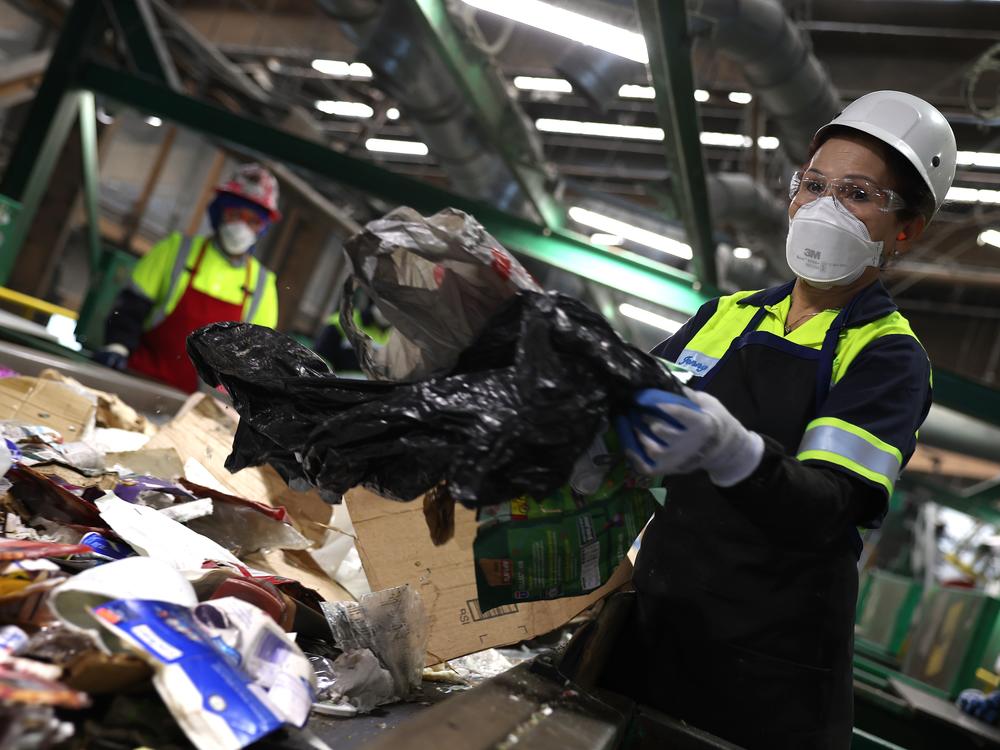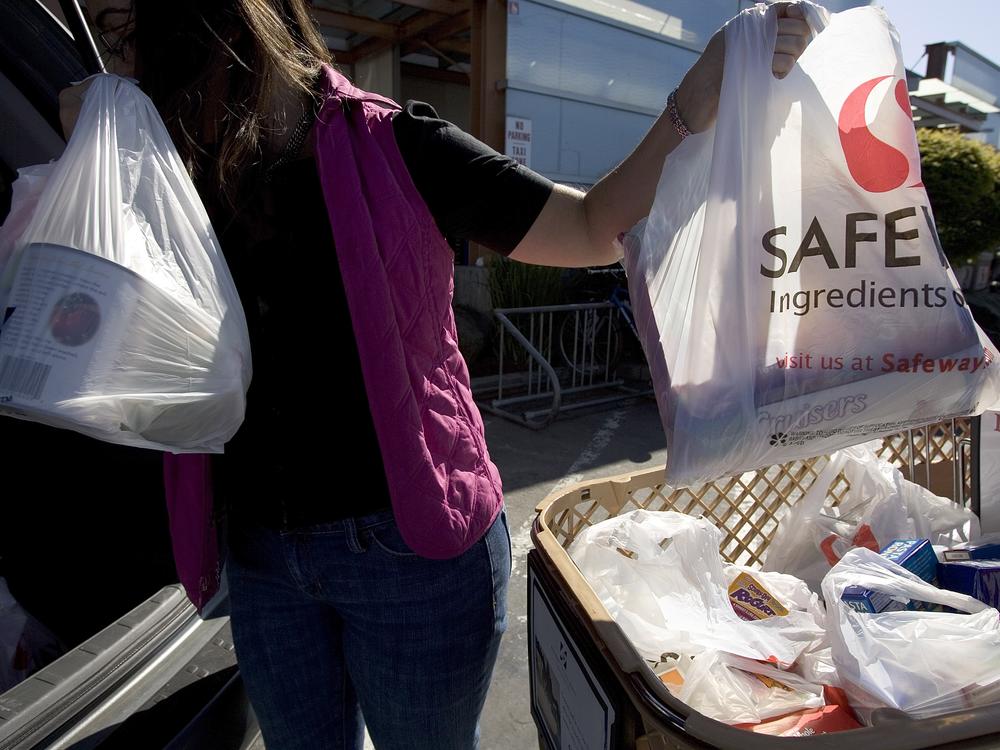Section Branding
Header Content
California’s first plastic bag ban made things worse. Now it’s trying again
Primary Content
Ten years after California approved a plastic bag ban that’s been blamed for making its plastic bag problem worse, the state is banning single-use plastic grocery bags entirely.
In 2014, California became the first state to pass a plastic bag ban. It’s one of at least 12 states that now have some form of ban on single-use plastic bags.
But because of a loophole in its initial ban that allowed grocers to charge for thicker plastic bags, California still dumped 231,072 tons of plastic grocery and merchandise bags in landfills in 2021, according to the state’s recycling agency, CalRecycle. That was a sharp increase from the year the ban took effect — and nearly 100,000 more tons than in 2018.
California officials are saying that there's a perception that plastics — especially plastic bags — can be easily recycled. But they say that this is not the reality and that consumers have been deceived for decades.
“CalRecycle has not identified facilities that recycle plastic bags in the state of California,” the agency told NPR this week.
The state filed a suit on Sunday alleging that ExxonMobil promoted recycling while knowing that it was technically and economically challenging and wouldn't make much of a dent in the plastic waste problem.
Here’s a rundown of California’s new ban and similar measures:
Why did California’s initial bag ban backfire?
The state’s ban on thin single-use bags had a loophole that let grocers sell shoppers thicker plastic bags for a small fee: just 10 cents. In theory, the heavier bags were reusable. But in practice, they became a more substantial form of waste.
“A plastic bag has an average lifespan of 12 minutes and then it is discarded, afflicting our environment with toxic microplastics that fester in our oceans and landfills for up to 1,000 years,” Sen. Catherine Blakespear, an author of the new ban, said in a news release issued after Gov. Gavin Newsom signed the ban into law on Sunday.
The initial ban was also undermined by the COVID-19 pandemic. When it was still unknown how the coronavirus spread, shoppers were barred from bringing reusable bags into grocery stores out of fear that their bags might be contaminated.
“California kind of took one for the team as the first to pass a statewide ban on plastic bags,” Melissa Valliant, communications director for the advocacy group Beyond Plastics, told NPR. “It ended up providing a lesson for other state and even local governments to learn from and to not allow loopholes like thicker plastic bags.”
What does the new California law do?
Starting on Jan. 1, 2026, customers at most grocery stores, convenience stores, and other retailers will have three main options: Pay at least 10 cents for a paper bag; use a reusable bag; or hand-carry their purchase.
“Stores may offer paper bags at the point-of-sale, and they can also sell the canvas-style reusable bags in other areas of the store,” Nate Rose of the California Grocers Association, which supports the new ban, told NPR.
“These are the bags many shoppers are already accustomed to bringing with them to carry their groceries,” Rose added.
And starting in 2028, stores’ paper bags will be required to be composed of at least 50% postconsumer recycled materials.
More than 70 organizations supported the legislation, member station LAist reports, saying it “would prevent plastic waste, which releases toxic chemicals into the air, water and soil.”
What’s so bad about plastic bags?
Despite industry claims about their recyclability, the thin bags are notoriously difficult and expensive to process and recycle. Instead, they often wind up in landfills, where they will persist for centuries, or in incinerators.
For a sense of the scale of the problem, consider Philadelphia. An evaluation commissioned by the city said last year that in Philadelphia, “an estimated 1 billion single-use disposable plastic bags are used annually,” adding to waste, litter and emissions challenges.
Municipal systems, the evaluation stated, “are unable to recycle plastic bags and the soft material causes equipment jamming at recycling centers, leading to dangerous and costly repairs that account for 150 hours of lost staff time and $300,000 in city costs.”
In contrast, restrictions like bag bans “can be expected to eliminate almost 300 single-use plastic bags per person per year, on average,” according to an analysis by Environment America and the U.S. PIRG Education Fund that was published in January.
What does the plastic industry say?
Bag manufacturers are against bans on their products and they insist that the thin plastic film bag, made of polyethylene, makes more sense than the alternatives.
“A polyethylene bag is 100% recyclable and can be recycled into itself, is produced with low carbon emissions, and the PE is made domestically from natural gas,” a general manager of bag supplier Crown Poly said in a 2023 report prepared by Freedonia Custom Research on behalf of an industry group, the American Recyclable Plastic Bag Alliance.
“Conversely, PP [polypropylene] bags are produced overseas and imported, produce higher emissions than film bags, and are not recyclable. In fact, 99% of PP is virgin and does not contain post-consumer recycled material,” the report states.
Note: While single-use bags can technically be recycled, it’s not an easy or cost-effective process.
“To the extent they get recycled, a lot of polyethylene plastics get turned into low-grade materials. You can’t take a plastic bag and then make another plastic bag with the same properties out of it,” chemistry researcher John Hartwig of the University of California, Berkeley said in 2022, as he worked on ways to reuse the ubiquitous material.
The American Recyclable Plastic Bag Alliance and another industry group, the Plastics Industry Association, did not respond to NPR’s request for comment on the new California ban before this story was published.
Should people just use paper bags?
When bans on single-use plastic bags haven’t also included a fee on paper bags, their use has soared. In Portland, Ore., for instance, paper bag use shot up by nearly 500% after the city enacted a ban (and before the state imposed its own ban with a fee for paper alternatives).
A similar dynamic has played out in Philadelphia, where the proportion of supermarket shoppers using at least one paper bag tripled after a plastic-bag ban took effect without a fee for paper. A recent bid to tack on a 15-cent fee for paper bags was axed by a pocket veto.
Paper bags are easier to recycle than plastic, and more degradable. But environmental advocates want retailers and shoppers to move away from single-use bags of any type. They argue that a few minutes of convenience isn’t enough to justify cumbersome networks of bag collection, processing and production needed to recycle single-use bags.
“The whole goal is to get people to switch from disposable options — especially plastic, but disposable options altogether — to reusable and refillable options,” Valliant said. “Because ultimately that is going to be the most sustainable and the best for both environment and human health.”
Which 12 states have banned plastic bags?
In 2024, Colorado and Rhode Island enacted statewide bans on single-use plastic bags, joining 10 states that already had restrictions in place: California, Connecticut, Delaware, Hawaii, Maine, New Jersey, New York, Oregon, Vermont and Washington.
At their core, such bans are attempts to shift responsibility for plastic waste from consumers upstream — to retailers and, by extension, plastic producers.
The same week California’s new ban became law, the state opened another front in its battle with plastic waste by filing a lawsuit against oil and gas giant ExxonMobil, a leading producer of the polymers used to make single-use plastics.
“For decades, ExxonMobil has been deceiving the public to convince us that plastic recycling could solve the plastic waste and pollution crisis when they clearly knew this wasn’t possible,” California Attorney General Rob Bonta said.
Bonta accused ExxonMobil of profiting from “convincing consumers that they were responsible for the proliferation of plastic waste through their own personal habits, rather than through Mobil’s and Exxon’s efforts to produce an increasing number of plastic products designed for single-use.”



